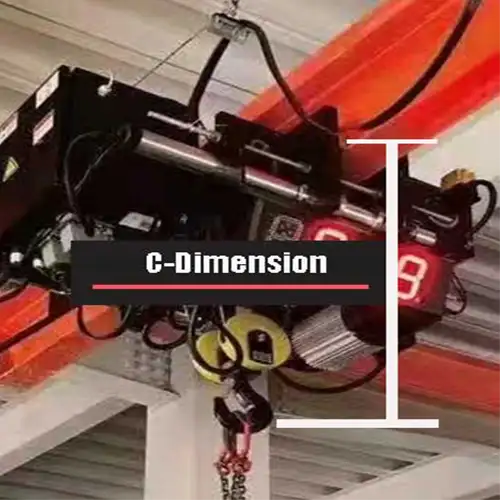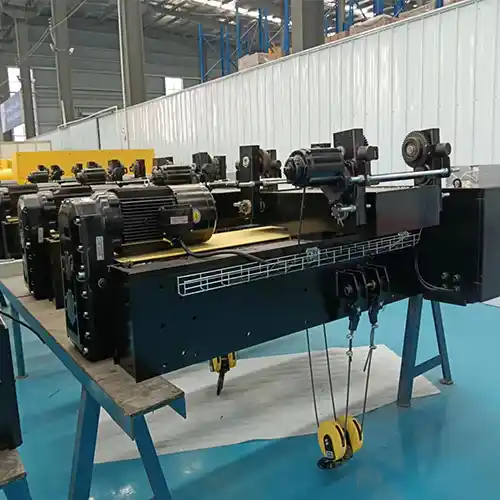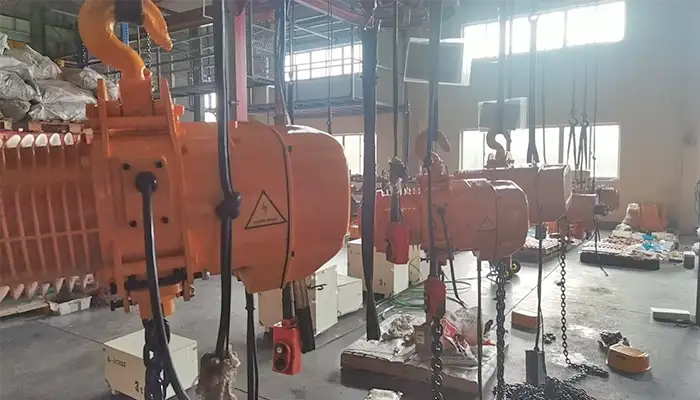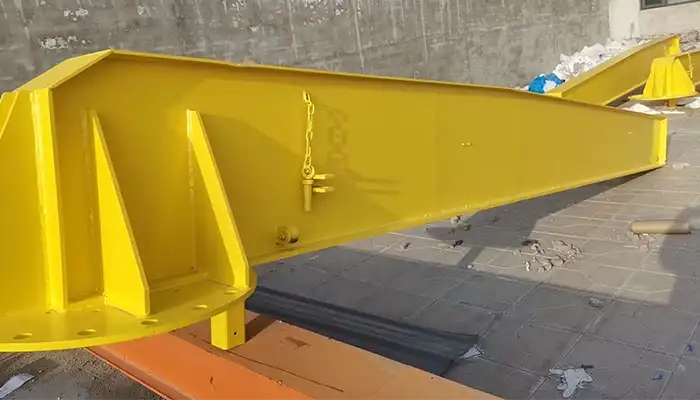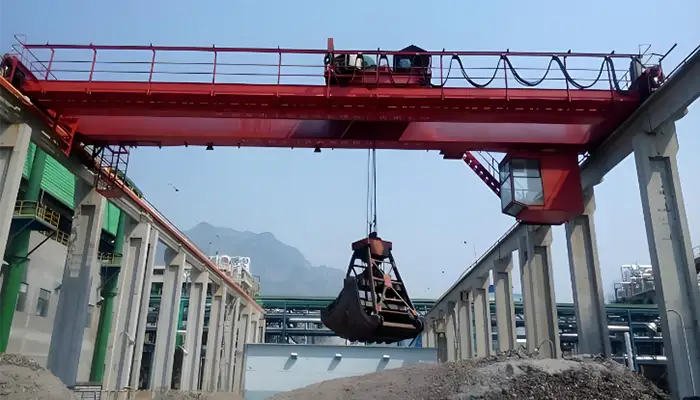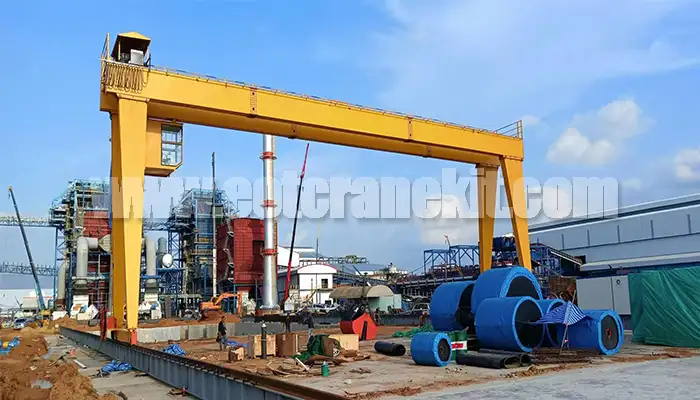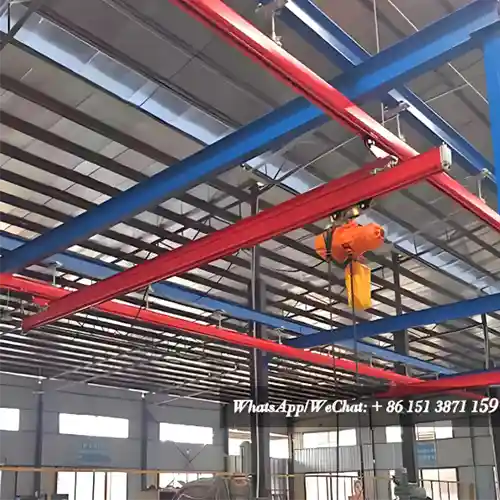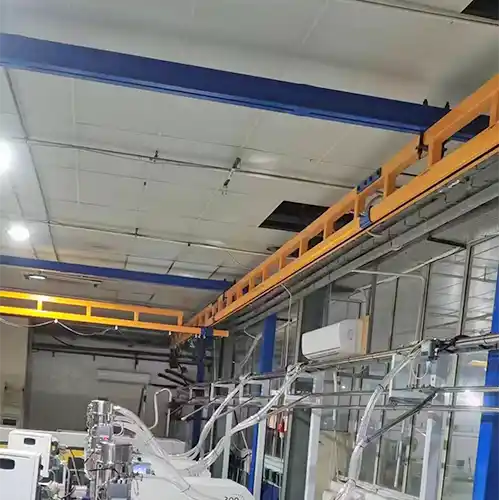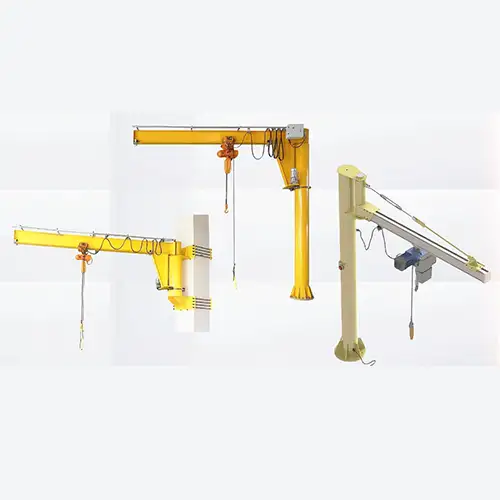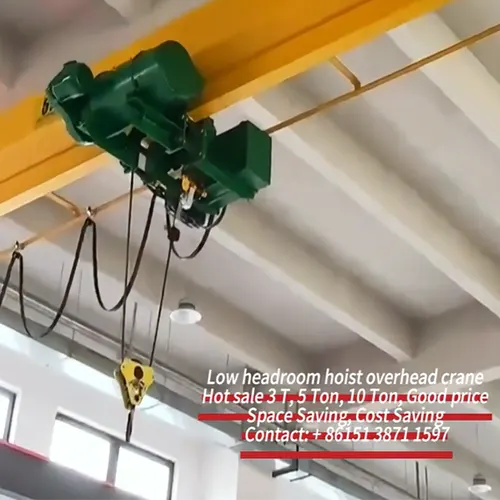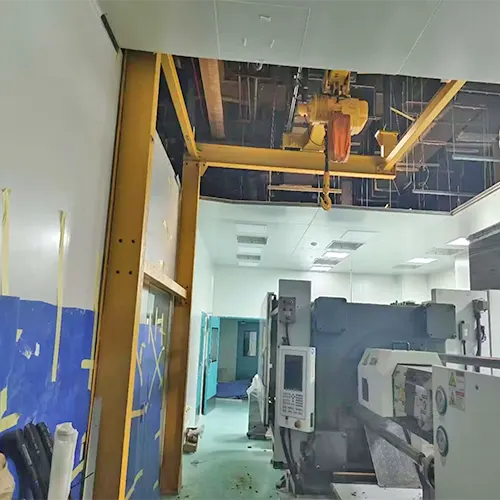Optimize Headroom for Workshop Cranes to Efficient Space Use
Optimizing headroom for overhead workshop cranes involves adjusting crane design & installation to maximize vertical space, improving operational efficiency & workspace utilization.
Category: Low Built Cranes & Hoists
Your Trusted Low Headroom Overhead Crane Manufacturer & Supplier
Optimizing Headroom for Overhead Workshop Cranes to Efficient Space Utilization
Optimizing headroom in overhead workshop cranes ensures efficient space utilization, enhancing operational flexibility and maximizing workspace efficiency.
Headroom in the context of overhead cranes refers to the vertical distance between the lowest point of the crane (often the bottom of the hoist or the trolley) and the highest point the crane's hook can reach when it is in its fully raised position. This measurement is crucial because it determines how much vertical space is left between the crane and any overhead obstructions, such as the ceiling or beams, and how much lifting height is available for moving loads.
Importance of Headroom in Ensuring Safe and Efficient Crane Operations
The amount of headroom available plays a vital role in both the safety and efficiency of crane operations. If the headroom is insufficient, the crane may not be able to lift loads to the necessary height, which can lead to dangerous situations, such as the load colliding with overhead structures. Additionally, inadequate headroom can limit the range of motion of the crane, reducing its overall effectiveness and leading to operational inefficiencies. Proper headroom allows for smooth lifting and lowering of loads, ensuring that the crane can operate within its designed capacity and that the workflow in the workshop remains uninterrupted and safe.
Relevance to Workshop Environments
Headroom considerations are especially crucial in workshop environments, where space is often at a premium. Many workshops are designed with specific height limitations, and the presence of beams, ventilation systems, and other overhead obstructions can further reduce the available space. In these settings, selecting a crane with the appropriate headroom becomes essential to maximizing the use of vertical space. Insufficient headroom in a workshop can lead to a range of problems, from reduced operational efficiency to potential safety hazards. Therefore, when planning the installation of an overhead crane in a workshop, careful attention must be paid to the headroom to ensure that the crane can perform its tasks without any risk of interference or accidents.(Click to check What is Overhead Crane's Lift Height, Headroom & C-dimension?)
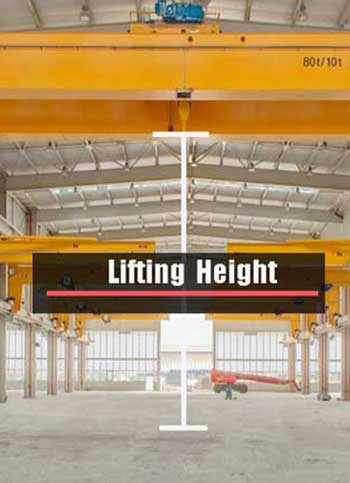
Hook Height or Lift Height:
When the crane hook is in its highest position, the hook height represents the required dimensions from the crane hook to the floor, another words, when the hook is in the upmost position, the distance from the hook to the floor is the required parameters of lifting height.
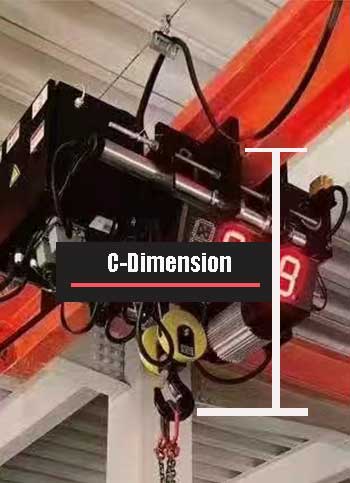
C-Dimension:
The C-Dimension refers to the distance between the running surface of the hoist trolley wheels and the hook saddle.The C-Dimension specifies the maximum height to which the hook can be lifted. It is the point determined by measuring between the running surfaces of the hook saddle and the hoist trolley wheels.
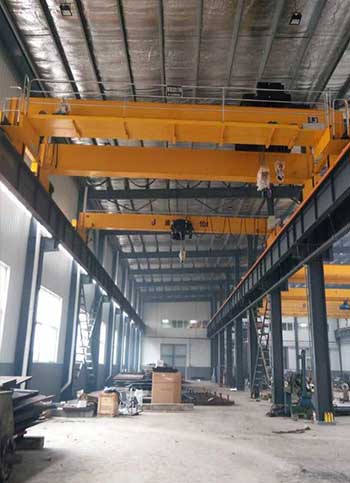
Headroom:
The space between the top of the lowest impediment and the top of the rail is the headroom available on an overhead crane.
Components of Headroom
Crane Design and Structure
The design and structure of an overhead crane significantly influence the amount of headroom required.
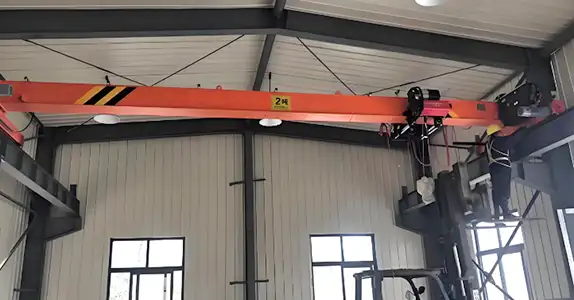
Single-Girder Workshop Cranes: These cranes feature a single bridge girder that supports the trolley and hoist. Single-girder cranes typically require less headroom because the hoist is mounted directly on the girder. This design is ideal for workshops with lower ceilings or where maximizing vertical space is essential. However, single-girder cranes may have limitations in terms of load capacity compared to double-girder designs.
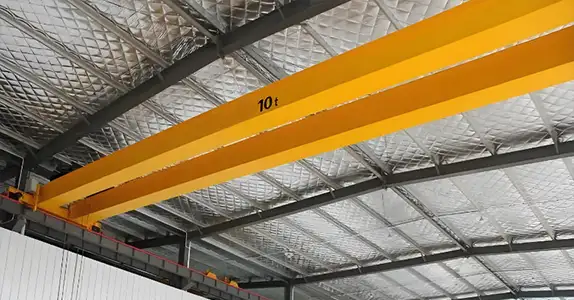
Double-Girder Workshop Cranes: In contrast, double-girder cranes have two bridge girders that support the hoist. The hoist can be placed between the girders or on top of them, providing greater lifting height but requiring more headroom. Double-girder cranes are often used in applications where heavy loads need to be lifted, but they require a workshop with sufficient vertical space to accommodate the extra height of the design.

Underhung Workshop Crane: These cranes feature a single bridge girder that supports the trolley and hoist. A single girder underslung crane features a single beam mounted below the supporting structure, offering efficient lifting in low headroom areas.

LDP Low Headroom Workshop Overhead Crane: LDP type low headroom overhead cranes feature a compact design for enhanced vertical space usage, ideal for low-clearance environments.
The choice between single-girder and double-girder cranes depends on the specific needs of the workshop, including the available headroom and the type of loads being handled.
Hook Approach and Load Height
The hook approach is another critical factor in determining the required headroom.
- Hook Approach: This term refers to the distance between the hook and the crane's structure when the hook is raised to its maximum height. A tighter hook approach means the hook can get closer to the crane's beam or girders, which is beneficial in workshops with limited headroom. Cranes with an optimized hook approach allow for more efficient use of vertical space, as they can lift loads higher without needing extra headroom.
- Load Height: The height of the loads being lifted also impacts headroom needs. Taller loads require more vertical space, meaning that the crane must have sufficient headroom to lift and move these loads safely. In workshops where a variety of load sizes are handled, the headroom must be sufficient to accommodate the tallest loads, ensuring that there is enough clearance above the load when it is lifted to its maximum height.
End Truck and Trolley Height
The height of the end trucks and trolleys also contributes to the total headroom required for an overhead crane.
- End Trucks and Trolleys: The end trucks are the components that move the crane along its runway, and the trolley is the mechanism that moves the hoist along the bridge girder. The height of these components adds to the overall headroom needed because they occupy vertical space within the crane's operating area. Taller trolleys and end trucks will increase the required headroom, potentially limiting the crane's ability to operate in workshops with lower ceilings.
- Under-Running vs. Top-Running Cranes: The difference in headroom requirements between under-running and top-running cranes is significant. Under-running cranes are suspended from the ceiling and operate below the runway, allowing for better utilization of vertical space, especially in low-ceiling workshops. Top-running cranes, on the other hand, run on rails mounted on top of the runway beams, requiring more headroom. While top-running cranes may offer advantages in terms of load capacity and stability, under-running cranes are often preferred in situations where headroom is limited.
Those crane components and how they affect headroom is crucial for selecting the right overhead crane for your workshop. By carefully considering crane design, hook approach, load height, and the height of end trucks and trolleys, you can ensure that your crane will operate efficiently and safely within the available vertical space.
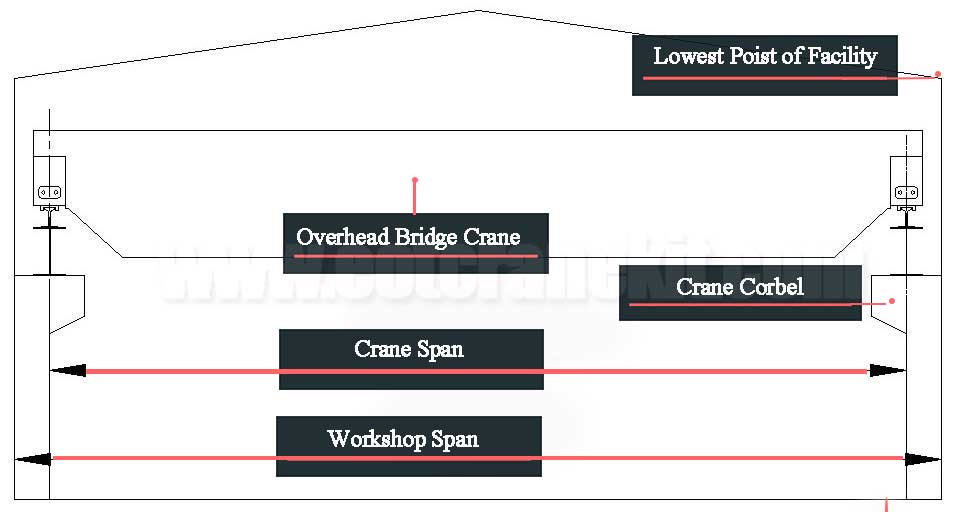
overhead crane specifications for your understanding
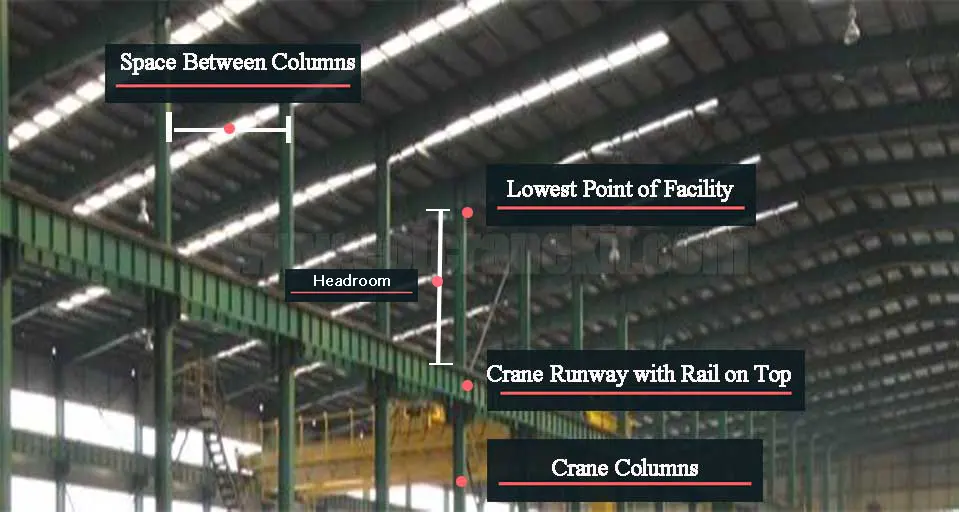
Workshop headroom that can be used by overhead cranes
Factors Influencing Headroom Requirements
Workshop Ceiling Height
The overall height of the workshop ceiling is one of the most critical factors in determining the headroom requirements for an overhead crane.
- Ceiling Height Impact: A higher ceiling provides more vertical space, allowing for a greater range of crane designs and lifting heights. In workshops with high ceilings, double-girder cranes or cranes with larger lifting capacities can be used without concern for headroom limitations. Conversely, in workshops with lower ceilings, the available headroom is limited, which restricts the type of crane that can be installed. In such cases, selecting a crane with a compact design, such as a single-girder crane with a low-headroom hoist, becomes necessary to maximize the lifting height within the restricted space.
- Considerations for Low-Ceiling Workshops: In workshops where the ceiling height is limited, special attention must be paid to the crane's design to ensure it can operate effectively. Low-headroom cranes are designed to fit into tight spaces, often featuring a hoist that is integrated into the trolley or mounted in a way that reduces the overall height of the crane. Additionally, under-running cranes, which operate below the runway beams, can be advantageous in low-ceiling environments because they reduce the amount of headroom required. Careful planning and selection of the appropriate crane design can help overcome the challenges posed by low ceilings, ensuring that the crane can still perform its intended functions safely and efficiently.
Load Characteristics
The characteristics of the loads being handled also play a significant role in determining the required headroom.
- Load Dimensions: The height, width, and shape of the loads directly impact the amount of headroom needed. Taller loads require more vertical space, which means the crane must be able to lift the load without risking contact with the ceiling or other overhead obstructions. The width and shape of the load can also affect how the crane is operated, particularly in terms of maneuvering the load within the available space. For example, wide or irregularly shaped loads may require additional clearance to be moved safely.
- Impact on Headroom: When selecting a crane, it's essential to consider the maximum dimensions of the loads that will be handled. If the loads are consistently large, the crane's design must accommodate this by providing sufficient headroom. This may involve choosing a crane with a greater lifting height or opting for a design that allows the hook to get as close to the ceiling as possible when fully raised. Ensuring that the crane can handle the largest loads without compromising safety or efficiency is crucial in maintaining smooth operations in the workshop.
Operating Environment
The specific conditions within the workshop, including the presence of obstructions and other environmental factors, significantly influence headroom requirements.
- Presence of Obstructions: Overhead obstructions, such as beams, ducts, lighting fixtures, and ventilation systems, can reduce the available headroom and complicate crane operations. These obstacles must be carefully mapped out during the planning phase to ensure that the crane can operate without interference. In some cases, custom crane designs or modifications may be needed to navigate around these obstructions while still providing adequate lifting capacity.
- Environmental Factors: The operating environment can also include factors like temperature, humidity, and the presence of dust or corrosive materials. These conditions may necessitate additional safety features or protective measures that could impact the overall design and headroom of the crane. For instance, cranes used in environments with high temperatures or corrosive atmospheres may require specialized coatings or insulation, which could increase the crane's overall height.
Regulatory and Safety Requirements
Regulatory standards and safety guidelines are crucial considerations when determining the headroom requirements for an overhead crane.
- Regulatory Standards: Depending on the region and industry, there may be specific regulations that dictate minimum headroom requirements for overhead cranes. These standards are designed to ensure that cranes can operate safely without risking collisions with overhead structures or loads. Compliance with these regulations is essential, not only for legal reasons but also to protect the safety of workers and the integrity of the equipment.
- Safety Considerations: Beyond regulatory compliance, additional safety considerations should be taken into account. For example, maintaining a safe clearance between the crane and any overhead obstructions is critical to prevent accidents. Ensuring that the crane has sufficient headroom to lift and lower loads smoothly without sudden stops or collisions is also important for preventing damage to the crane and the loads being handled. Safety should always be a top priority in crane operations, and headroom is a key factor in maintaining a safe working environment.
By carefully considering these factors—workshop ceiling height, load characteristics, operating environment, and regulatory requirements—you can determine the appropriate headroom for your overhead crane. This will help ensure that the crane can operate effectively within the constraints of your workshop, providing safe and efficient lifting capabilities.
Calculating Headroom Requirements for Your Workshop
Step-by-Step Guide to Measurement
- Measure the Workshop Ceiling Height: Start by measuring the total height of your workshop from the floor to the ceiling. This gives you the maximum possible vertical space available. Ensure you take multiple measurements at different points, especially if the ceiling is not uniform, to identify the lowest ceiling point.
- Identify and Measure Overhead Obstructions: Next, identify any potential overhead obstructions such as beams, ducts, lighting fixtures, and ventilation systems. Measure the distance from the floor to each obstruction and record the lowest point. This step is critical because the headroom calculation will need to account for these obstacles to avoid any interference during crane operation.
- Determine the Maximum Load Height: Measure the maximum height of the loads that will be lifted by the crane. This includes not just the physical height of the load but also any additional clearance needed for safe handling. Consider the tallest load you expect to handle regularly, as this will influence the required headroom.
- Measure the Crane Components: Finally, measure the height of the crane components, including the hoist, trolley, and end trucks. If you haven't selected a crane yet, consult with the crane manufacturer to get accurate dimensions for the model you are considering. Knowing the height of these components will help you determine how much vertical space they will occupy.
- Calculate Available Headroom: Subtract the height of the crane components, overhead obstructions, and the maximum load height from the total ceiling height. The remaining space is the available headroom. This calculation will inform whether the selected crane can operate effectively within your workshop's constraints.
Assessment of Available Space
Once you have accurate measurements, the next step is to assess how to optimize the available space.
- Space Optimization: If the available headroom is limited, consider options such as low-headroom cranes or under-running cranes that make better use of vertical space. Reorganizing the layout of overhead obstructions, if possible, can also free up additional headroom. For example, relocating ventilation ducts or adjusting the position of lighting fixtures might provide the extra clearance needed for the crane to operate more effectively.
- Adjusting Crane Selection: Based on your headroom calculations, you may need to reconsider the type of crane you initially planned to install. If the headroom is insufficient for a standard design, look into custom solutions or cranes specifically designed for low headroom environments. These adjustments can prevent operational challenges and ensure the crane fits seamlessly into your workshop.
Examples of Headroom Calculations
Example 1: Single-Girder Crane in a Low-Ceiling Workshop
Consider a workshop with a ceiling height of 20 feet. There are beams running across the ceiling at 18 feet, leaving 2 feet of clearance. The loads to be lifted are 6 feet tall. You choose a single-girder crane with a hoist that occupies 2 feet of headroom. The calculation would be as follows:
- Total Ceiling Height: 20 feet
- Height of Beams: 18 feet
- Height of Load: 6 feet
- Hoist Height: 2 feet
Available Headroom: 18 feet (ceiling height minus beams) - 6 feet (load height) - 2 feet (hoist height) = 10 feet of headroom for lifting.
In this scenario, the crane will have adequate headroom to lift the load without hitting the beams, but if the load or hoist height were increased, the available headroom would decrease.
Example 2: Double-Girder Crane in a High-Ceiling Workshop
Now, imagine a workshop with a ceiling height of 30 feet and no significant overhead obstructions. The loads are 10 feet tall, and you're considering a double-girder crane with a hoist that occupies 4 feet of headroom. The calculation is as follows:
- Total Ceiling Height: 30 feet
- Height of Load: 10 feet
- Hoist Height: 4 feet
Available Headroom: 30 feet (ceiling height) - 10 feet (load height) - 4 feet (hoist height) = 16 feet of headroom for lifting.
In this case, there is ample headroom available, allowing for safe and efficient crane operation. The double-girder crane's higher headroom requirement is easily accommodated in this environment.
These examples illustrate the importance of careful measurement and assessment in determining the appropriate headroom for your overhead crane. By following these steps, you can ensure that your crane operates safely and effectively within the constraints of your workshop.
Solutions for Workshops with Limited Headroom
Low-Headroom Crane Designs
In workshops where vertical space is at a premium, low-headroom crane designs offer an effective solution.
- Specialized Low-Headroom Designs: These cranes are engineered to minimize the space they occupy, allowing for greater lifting heights even in areas with limited ceiling clearance. Common features include compact hoists integrated into the trolley or mounted sideways to reduce the overall height. Additionally, low-headroom cranes often use shorter end trucks and modified girders to further decrease the amount of headroom required.
- Benefits and Limitations: The primary benefit of low-headroom crane designs is their ability to operate in environments where standard cranes would be too tall. This makes them ideal for workshops with low ceilings or areas with numerous overhead obstructions. However, the compact design may come with some limitations, such as reduced load capacity or a narrower range of motion. It's essential to balance these factors with your workshop's needs to determine if a low-headroom crane is the best fit.
- Comparison to Standard Designs: While standard cranes offer greater versatility and higher load capacities, they require more headroom. In contrast, low-headroom cranes are specifically designed to maximize the available space, making them more suitable for workshops with height restrictions. When deciding between these options, consider the specific requirements of your operations, including the typical load sizes, ceiling height, and the presence of any overhead obstructions.
Under-Running Cranes
Under-running cranes provide another effective solution for workshops with limited headroom.
- Reduction in Headroom Requirements: Under-running cranes are suspended from the ceiling and operate below the runway beams, which allows them to utilize the vertical space more efficiently. Unlike top-running cranes, which require additional headroom to accommodate the runway, under-running cranes eliminate this need by positioning the crane beneath the runway system. This design significantly reduces the overall headroom required for crane operation.
- Applications for Under-Running Cranes: Under-running cranes are particularly effective in environments where the ceiling height is low or where overhead obstructions would interfere with the operation of a top-running crane. They are commonly used in smaller workshops, manufacturing facilities, and areas with complex layouts that require precise maneuverability. Additionally, under-running cranes can be designed to run along curved tracks or navigate around obstacles, providing further flexibility in constrained spaces.
Custom Crane Solutions
For workshops with unique headroom constraints, custom crane solutions may be necessary to achieve optimal performance.
- Tailored Crane Designs: Custom cranes are designed specifically to meet the unique challenges of your workshop environment. This might involve modifying the crane's structure, such as lowering the profile of the girders or creating a bespoke trolley design that minimizes height. Custom solutions also include the integration of advanced control systems that allow for more precise operation in tight spaces, ensuring that the crane can perform its tasks safely and efficiently within the limited headroom.
- Considerations for Custom Designs: When exploring custom crane solutions, it's essential to work closely with an experienced crane manufacturer who can assess your specific needs and constraints. Factors to consider include the type of loads being handled, the available ceiling height, the layout of the workshop, and any potential obstructions. Custom designs often require a more significant investment, but they can provide the best long-term solution for maximizing productivity and safety in workshops with headroom limitations.
- Examples of Custom Solutions: In some cases, workshops with extremely low ceilings or unusual layouts have successfully implemented custom crane solutions that wouldn't be possible with standard designs. For example, a workshop with a ceiling height of only 12 feet might use a custom-built, low-profile crane with a side-mounted hoist to maximize lifting height. Another example might be a facility with numerous overhead pipes and ducts, where a custom under-running crane system is designed to navigate around these obstacles while still providing adequate lifting capacity.
By considering these solutions—low-headroom crane designs, under-running cranes, and custom crane solutions—you can overcome the challenges posed by limited headroom in your workshop. Each option offers unique benefits that can be tailored to meet the specific needs of your environment, ensuring safe and efficient crane operations even in the most constrained spaces.
Optimizing Crane Selection for Your Workshop
Matching Crane Type to Workshop Needs
Selecting the right crane for your workshop is crucial, especially when headroom is a limiting factor. The first step in optimizing crane selection is to align the crane type with your workshop's specific needs.
- Assessing Operational Requirements: Start by analyzing your workshop's operational needs, such as the types of loads you'll be lifting, the frequency of crane use, and the layout of your workspace. For workshops with limited headroom, consider cranes specifically designed to operate in tight vertical spaces, like low-headroom cranes or under-running cranes. If your operations require lifting heavy or oversized loads, you may need to balance the headroom requirements with the necessary lifting capacity, potentially opting for a custom solution.
- Choosing the Right Crane Design: The design of the crane—whether single-girder, double-girder, top-running, or under-running—will have a direct impact on the available headroom and the crane's operational efficiency. Single-girder cranes typically require less headroom compared to double-girder cranes, making them a better choice for workshops with lower ceilings. Under-running cranes are ideal for maximizing vertical space, especially in facilities with overhead obstructions or complex layouts. However, if your workshop has sufficient headroom and requires higher load capacities, a double-girder top-running crane might be more suitable.
Cost Considerations
Understanding the cost implications of your crane selection is essential for making an informed decision that balances functionality with budget constraints.
- Initial Costs vs. Long-Term Savings: Low-headroom and custom crane designs often come with higher upfront costs due to the specialized engineering required. However, these initial investments can lead to long-term savings by ensuring that the crane operates efficiently within the space constraints, reducing the likelihood of costly modifications or replacements in the future. Additionally, a well-chosen crane can minimize downtime and improve productivity, further justifying the initial expenditure.
- Comparing Standard and Custom Solutions: While standard cranes are generally more affordable, they may not provide the optimal performance in workshops with headroom limitations. Custom cranes, while more expensive, are tailored to meet your specific needs, potentially offering greater efficiency and safety in the long run. It's important to weigh the immediate cost savings of a standard crane against the potential operational challenges and future expenses that might arise if the crane doesn't fully meet your workshop's requirements.
- Budgeting for Maintenance and Upgrades: When selecting a crane, consider not only the purchase price but also the ongoing maintenance costs. Custom cranes may require specialized parts or servicing, which could increase long-term costs. However, investing in a high-quality, well-designed crane from the outset can reduce maintenance needs and extend the crane's lifespan, ultimately leading to cost savings over time.
Future-Proofing Your Investment
Ensuring that your crane choice remains viable as your workshop evolves is crucial for maximizing the return on your investment.
- Anticipating Future Needs: Consider how your workshop's operations might change in the future. For instance, if you anticipate handling larger loads or reconfiguring the workspace, choose a crane that offers the flexibility to adapt to these changes. Opting for a crane with adjustable features, such as variable lifting heights or modular components, can help future-proof your investment.
- Scalability and Upgradability: Select a crane that can be easily upgraded or expanded as your needs grow. This might include choosing a crane with a higher load capacity than currently required or selecting a model that can be modified with additional features, such as remote controls or advanced safety systems, as your operations evolve. A scalable crane solution can save you from needing a complete replacement as your workshop demands increase.
- Considering Long-Term Compliance: Regulatory standards and safety requirements can change over time. Ensure that your crane not only meets current regulations but can also be adapted to comply with future standards. This might involve choosing a crane from a manufacturer known for providing updates or retrofits to existing models, ensuring that your equipment remains compliant and safe to operate for years to come.
By carefully matching the crane type to your workshop's needs, considering the cost implications, and planning for future requirements, you can optimize your crane selection to ensure it delivers value both now and in the years to come. This approach will help you make a sound investment that enhances the efficiency, safety, and longevity of your workshop operations.
Conclusion: Custom Low Headroom Overhead Cranes for Your Needs
For overhead cranes, headroom is a critical factor that directly impacts the safety, efficiency, and overall functionality of your workshop. Throughout this discussion, we've explored the definition and significance of headroom, especially within constrained workshop environments where every inch of vertical space counts. We've delved into the components of headroom, such as crane design, hook approach, and trolley height, and examined the various factors that influence headroom requirements, including ceiling height, load characteristics, and the operating environment.
Moreover, we've discussed practical solutions for workshops with limited headroom, such as low-headroom crane designs, under-running cranes, and custom crane solutions, each tailored to overcome specific space constraints. Additionally, we've provided insights into optimizing crane selection by aligning the crane type with your operational needs, considering cost implications, and future-proofing your investment to ensure long-term success.
Final Recommendations
For workshop managers facing headroom constraints, selecting the right overhead crane requires careful consideration of both current and future operational needs. Here are some actionable steps to guide your decision-making process:
- Accurately Measure and Assess Your Space: Begin by conducting a thorough assessment of your workshop's available headroom and any potential obstructions. This will help you identify the most suitable crane type and design for your specific environment.
- Prioritize Functionality and Safety: Choose a crane that not only fits within your headroom limitations but also meets your operational requirements in terms of load capacity, lifting height, and maneuverability. Ensure that the crane's design aligns with safety standards and allows for efficient and secure handling of loads.
- Consider Long-Term Value Over Initial Costs: While it may be tempting to opt for a less expensive standard crane, investing in a low-headroom or custom-designed crane can provide greater long-term benefits by enhancing productivity, reducing downtime, and avoiding costly modifications in the future.
- Plan for Future Needs: Anticipate potential changes in your workshop operations, such as increases in load size or reconfigurations of the workspace. Select a crane that offers flexibility and scalability to adapt to these evolving needs, ensuring that your investment remains viable for years to come.
By following these recommendations, workshop managers can make informed decisions that optimize the use of vertical space, enhance operational efficiency, and ensure the safety and longevity of their overhead crane systems. Ultimately, understanding and optimizing headroom is key to achieving the best possible outcomes for your workshop.
Main Projects
Related Products
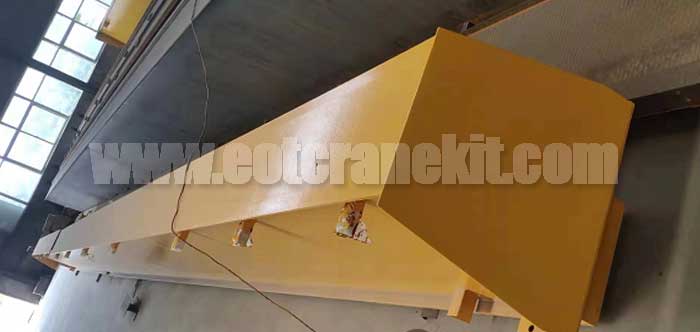
6.3 ton overhead crane kit for sale Philippines, complete single girder top running overhead crane system, low headroom design for workshop indoor use.
Free consultation to Confirm Parameters & Specifications and Get
Latest Crane Price & Crane Rate.
- Types of overhead cranes : _______?
- Optional: Overhead travelling crane, goliath gantry crane,Slewing jib crane, Single girder or double girder crane,small portable crane or kbk crane, etc.
- Capacity of overhead crane: _______?
- Optional: 0.25ton, 0.5 ton, 1 ton, 2 ton, 3ton, 5 ton, 10 ton,15ton, 20ton, 25 ton, 30ton,35ton, up to 550ton, etc.
- Crane span & lifting height : _______?
- Crane travelling length : _____?
- Control of overhead crane:_______?
- Optional: pendant/ remote/cabin control
- Voltage supply of overhead crane:_____?
- Eg,: 380V50/60HZ,3Phase or others,etc.
- Application/usage of crane:_______?
- Eg,: Steel mill, ,injection mold, cement,stone, concrete,granite, general manufacturing, etc.
Just leave a message via the contact form and our hoist and crane engineer will contact you with in 24working hours.
Get In Touch
